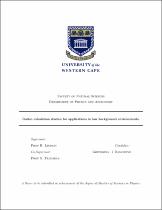| dc.contributor.advisor | Lindsay, R | |
| dc.contributor.author | Ramonnye, Goitseona. J | |
| dc.date.accessioned | 2023-04-18T08:41:20Z | |
| dc.date.available | 2023-04-18T08:41:20Z | |
| dc.date.issued | 2023 | |
| dc.identifier.uri | http://hdl.handle.net/11394/9803 | |
| dc.description | >Magister Scientiae - MSc | en_US |
| dc.description.abstract | Neutrinoless double beta decay (0νββ) is a rare process that is yet to be observed. Observation of neutrinoless double beta decays would imply lepton number violation, and that the neutrino is its own antiparticle (a
Majorana fermion). Understanding background contributions are important in searches for such rare nuclear
processes. This thesis details the design and operation of a radon detector in the context of low-background
deep-underground experiments, such as the one pursued by the nEXO neutrinoless double beta decay collaboration.
Most sensitive rare search experiments are located deep underground to shield from cosmic radiation. However, radon presents itself as a pervasive source of background in such environments. Radon is the only
daughter in the uranium and thorium decay chains that is gaseous, so it has the ability to escape materials
either through pores or diffusion through material. This background would potentially make any rare physics
search ineffective, as the signals of interest may be clouded by background noise. | en_US |
| dc.language.iso | en | en_US |
| dc.publisher | University of the Western Cape | en_US |
| dc.subject | Cosmic radiation | en_US |
| dc.subject | Radon | en_US |
| dc.subject | Nuclear | en_US |
| dc.title | Radon exhalation studies for applications in low background environments. | en_US |
| dc.rights.holder | University of the Western Cape | en_US |

